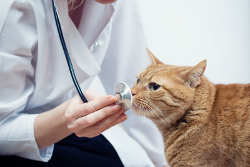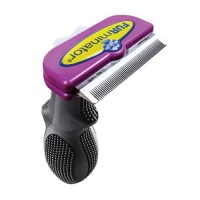This article will cover the important things you need to know about choosing a quality feline brush and why the FURminator is our top choice.
Don’t Let Your Cat Fool You
The common notion is that cats are independent and don’t need us for much. They only see us as a warm spot to snooze on, or as giant can openers. It’s true that cats are the regal loners of the pet kingdom, but they do need our help sometimes, even when they are too arrogant to admit it.
Why Cats Are Always Grooming
When cats are not catching up on their beauty sleep, they are grooming. Cats groom for various reasons.
- They groom after eating, because in the wild they need to remove all traces of a fresh kill in order to avoid altering other predators.
- Cats can groom for comfort or stress relief.
- They also groom to keep their body temperature cool through the evaporation process.
Why Raspy Tongues Are Just Not Enough
Their rough tongues are covered in a collection of miniscule barbs called papillae. Your cat’s tongue is her spoon for sipping milk, her lint roller, and her brush. While grooming, her tongue catches any debris, dirt, and loose fur that she will inevitably swallow. This is what causes hairballs. When a large collection of the aforementioned particles gather in the esophagus or stomach, your cat gets rid of it. She will bring it back up, and onto your new rug.
If a cat is excessively shedding or has a long coat, hairballs are more frequent. A way to help your cat (and your rug) avoid this unpleasant experience is by assisting your cat with her grooming.
The Benefits of Brushing Your Cat
- It prevents hairballs. Sometimes, hairballs can cause obstructions in the gastrointestinal system. The more you brush your cat, the less hair she will ingest and the less frequent her production of hairballs will be.
- It prevents tangles and matting. Longhaired breeds are especially prone to matting. Brushing your cat spreads her natural oils throughout her fur, keeping it shiny, healthy and tangle-free.
- It promotes bonding. Brushing your cat is a great way to bond with her. Cat’s socially groom each other as a form of affection. To your cat, you are showing her love by grooming her the way a littermate or her mother would.
Selecting a Brush
There are numerous brushes and combs out there. The right brush or comb depends on the length, density and texture of your cat’s fur. Slicker brushes are often used for longhaired cats that have soft coats. Brushes that have shorter teeth work better for short fur. Gloves that have a rubber palm with ridges or projections to catch fur, only work on the topcoat.
The petting motion you use while wearing it swipes up all the loose superficial hair, but the majority remains underneath the topcoat waiting to be picked up by your cat’s tongue during grooming.
The FURminator Cat Brush : Not Just Your Regular Brush
By far, the best tool out there to remove dead hair and reduce shedding is the FURminator. There is a very good reason why professional pet stylists use it in their salons and why your vet will recommend the FURminator if your cat is having trouble with excessive hairballs. Most breeds of cats have three layers of hair that make up their coat: the topcoat, the guard hair, and the undercoat.
The FURminator decreases shedding by getting down into the undercoat and removing dead hair. Other brushes only sweep through the fur and remove hair from the first two layers. Because the FURminator goes deeper into the coat to remove hair from the undercoat, you only need to use it one to two times a week as opposed to every other day like a regular brush.
Your cat will thank you (in her own way) for the reduction of hairballs and for the time you spend brushing her.
Thanks for www.catdandruffclinic.com, if you liked this article please like us using the side bar social buttons.



[…] first thing that will need to be done is clipping the hair around the infected area. The next step will be draining the abscess, this will usually happen on […]